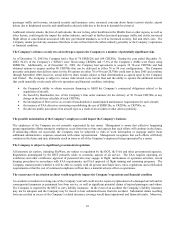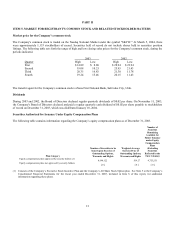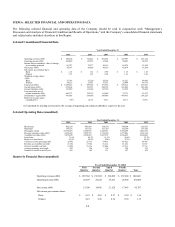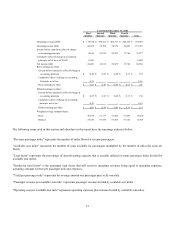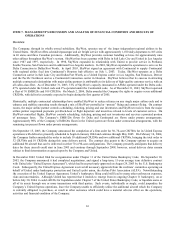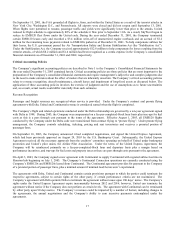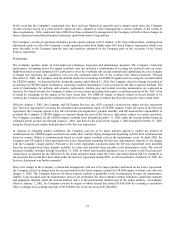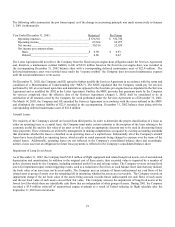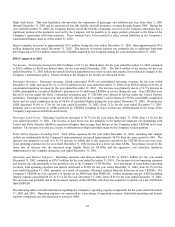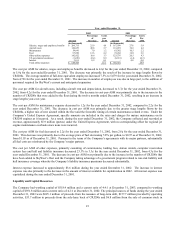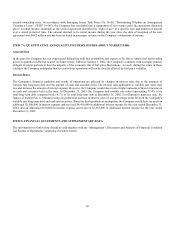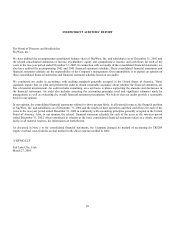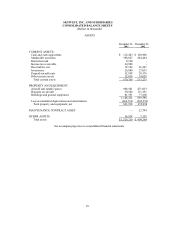SkyWest Airlines 2003 Annual Report Download - page 22
Download and view the complete annual report
Please find page 22 of the 2003 SkyWest Airlines annual report below. You can navigate through the pages in the report by either clicking on the pages listed below, or by using the keyword search tool below to find specific information within the annual report.
The following table summarizes the pro forma impact as if the change in accounting principle was made retroactively to January
1, 2001 (in thousands):
Year Ended December 31, 2001: Historical Pro Forma
Operating expenses $ 536,301 $ 532,788
Operating income 65,564 69,077
Net income 50,516 52,659
Net income per common share:
Basic $ 0.90 $ 0.93
Diluted
0.88 0.92
The Letter Agreement did not relieve the Company from the fixed rate per-engine-hour obligation under the Services Agreement
and, therefore, a maintenance contract liability to GE of $22.8 million based on the fixed rate per-engine-hour, was recorded in
the accompanying December 31, 2002 balance sheet with a corresponding deferred maintenance asset of $22.8 million. The
deferred maintenance asset was recorded since under the “expense method” the Company does not record maintenance expense
until the actual maintenance event occurs.
On December 31, 2002, the Company and GE agreed to further modify the Services Agreement in accordance with the terms and
conditions of a Memorandum of Understanding (the “MOU”). The MOU stipulated that the Company would pay for services
performed by GE at a rate based upon time and materials as opposed to the fixed rate per-engine-hour as stipulated in the Services
Agreement and as modified for 2002 in the Letter Agreement. Further, the MOU provides that payments made by the Company
for services completed since the effective date of the Services Agreement (August 1, 2002) shall be considered to be in
satisfaction of all amounts owed by the Company for work performed under the Services Agreement as of December 31, 2002.
On March 14, 2003, the Company and GE amended the Services Agreement in accordance with the terms outlined in the MOU
and eliminated the contract liability of $22.8 recorded in the accompanying December 31, 2002 balance sheet along with the
corresponding deferred maintenance asset of $22.8 million.
Aircraft Leases
The majority of the Company's aircraft are leased from third parties. In order to determine the proper classification of a lease as
either an operating lease or a capital lease, the Company must make certain estimates at the inception of the lease relating to the
economic useful life and the fair value of an asset as well as select an appropriate discount rate to be used in discounting future
lease payments. These estimates are utilized by management in making computations as required by existing accounting standards
that determine whether the lease is classified as an operating lease or a capital lease. Substantially all of the Company's aircraft
leases have been classified as operating leases, which results in rental payments being charged to expense over the terms of the
related leases. Additionally, operating leases are not reflected in the Company’s consolidated balance sheet and accordingly,
neither a lease asset nor an obligation for future lease payments is reflected in the Company's consolidated balance sheet.
Impairment of Long Lived Assets
As of December 31, 2003, the Company had $742.8 million of flight equipment and related long-lived assets, net of accumulated
depreciation and amortization. In addition to the original cost of these assets, their recorded value is impacted by a number of
policy elections made by the Company, including estimated useful lives and salvage values. The Company reviews its long-lived
assets for impairment upon certain triggering events, such as a reduction to fleet lives, at each balance sheet date that may indicate
the book value of an asset may not be recoverable. The Company uses an estimate of future undiscounted net cash flows of the
related asset or group of assets over the remaining life in measuring whether the assets are recoverable. The Company records an
impairment charge if the net book value of the assets being assessed exceeds future undiscounted net cash flows of such assets
and the net book value of such assets exceed their fair value. The Company assesses the impairment of long-lived assets at the
lowest level for which there are identifiable cash flows that are independent of other groups of assets. During 2001, the Company
recorded a $3.4 million write-off of unamortized engine overhauls as a result of United reducing its flight schedule after the
September 11, 2001 terrorist attacks.
19



